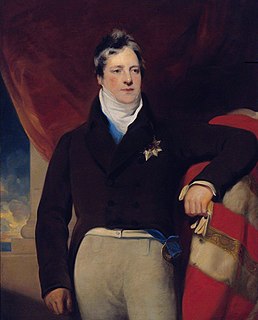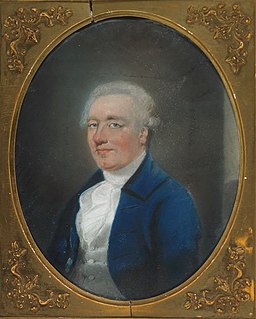
Marquess of Ely, of the County of Wexford, is a title in the Peerage of Ireland. It was created in 1800 for Charles Loftus, 1st Earl of Ely. He was born Charles Tottenham, the son of Sir John Tottenham, 1st Baronet, who had been created a baronet, of Tottenham Green in the County of Wexford, in the Baronetage of Ireland in 1780, by Elizabeth, daughter of Nicholas Loftus, 1st Viscount Loftus, sister and heiress of Henry Loftus, 1st Earl of Ely. In 1783 he succeeded to the Loftus estates on the death of his maternal uncle the Earl of Ely and assumed the same year by Royal licence the surname of Loftus in lieu of his patronymic. In 1785 he was raised to the Peerage of Ireland as Baron Loftus, of Loftus Hall in the County of Wexford. It was sold by the family in 1917 and is today owned by the Quigley family.
The Earl of Courtown, in the County of Wexford, is a title in the Peerage of Ireland. It was created on 12 April 1762 for James Stopford, 1st Baron Courtown. He had previously represented County Wexford and Fethard in the Irish House of Commons. Stopford had already been created Baron Courtown, of Courtown in the County of Wexford, on 19 September 1758, and was made Viscount Stopford at the same time he was given the earldom. These titles are also in the Peerage of Ireland. He was succeeded by his eldest son, the second Earl. He was a Tory politician and served under William Pitt the Younger as Treasurer of the Household from 1784 to 1793. On 7 June 1796 he was created Baron Saltersford, of Saltersford in the County Palatine of Chester, in the Peerage of Great Britain. This title gave him and his descendants an automatic seat in the House of Lords.
Nathaniel Clements, 2nd Earl of Leitrim, KP PC (Ire), styled The Honourable from 1783 to 1795, and then Viscount Clements to 1804, was an Irish nobleman and politician.
This is a list of people who have served as Lord-Lieutenant of Wexford.
Wexford County was a UK Parliament constituency in Ireland, which returned two Members of Parliament (MPs) to the United Kingdom House of Commons.
Sir Henry Watkin Dashwood, 3rd Baronet was an English country landowner and politician who sat in the House of Commons between 1775 and 1795.

Archibald Acheson, 3rd Earl of Gosford KP, styled Viscount Acheson between 1807 and 1849, was a British peer and Member of Parliament.

Arthur Saunders Gore, 2nd Earl of Arran KP, PC (Ire) styled The Honourable Arthur Gore from 1758 to 1762 and Viscount Sudley from 1762 to 1773, was an Irish peer and politician.

James George Stopford, 3rd Earl of Courtown KP, PC, known as Viscount Stopford from 1770 to 1810, was an Anglo-Irish peer and Tory politician.
James Thomas Stopford, 4th Earl of Courtown, known as Viscount Stopford from 1810 to 1835, was an Anglo-Irish peer and Tory Member of Parliament.

John Loftus, 2nd Marquess of Ely KP, styled The Honourable John Loftus from 1785 to 1794 and Viscount Loftus from 1794 to 1806, was a British peer in both the Irish and British peerages.

Charles Tottenham Loftus, 1st Marquess of Ely, KP, PC was an Anglo-Irish peer and politician.
The High Sheriff of Carlow was the British Crown's judicial representative in County Carlow, Ireland from the 14th century until 1922, when the office was abolished in the new Free State and replaced by the office of Carlow County Sheriff. The sheriff had judicial, electoral, ceremonial and administrative functions and executed High Court Writs. In 1908, an Order in Council made the Lord-Lieutenant the Sovereign's prime representative in a county and reduced the High Sheriff's precedence. However the sheriff retained his responsibilities for the preservation of law and order in the county. The usual procedure for appointing the sheriff from 1660 onwards was that three persons were nominated at the beginning of each year from the county and the Lord Lieutenant then appointed his choice as High Sheriff for the remainder of the year. Often the other nominees were appointed as under-sheriffs. Sometimes a sheriff did not fulfil his entire term through death or other event and another sheriff was then appointed for the remainder of the year. The dates given hereunder are the dates of appointment. All addresses are in County Carlow unless stated otherwise.
The High Sheriff of County Kilkenny was the British Crown's judicial representative in County Kilkenny, Ireland from the 16th century until 1922, when the office was abolished in the new Free State and replaced by the office of Kilkenny County Sheriff. The sheriff had judicial, electoral, ceremonial and administrative functions and executed High Court Writs. In 1908, an Order in Council made the Lord-Lieutenant the Sovereign's prime representative in a county and reduced the High Sheriff's precedence. However the sheriff retained his responsibilities for the preservation of law and order in the county. The usual procedure for appointing the sheriff from 1660 onwards was that three persons were nominated at the beginning of each year from the county and the Lord Lieutenant then appointed his choice as High Sheriff for the remainder of the year. Often the other nominees were appointed as under-sheriffs. Sometimes a sheriff did not fulfil his entire term through death or other event and another sheriff was then appointed for the remainder of the year. The dates given hereunder are the dates of appointment. All addresses are in County Kilkenny unless stated otherwise.
The High Sheriff of Leitrim was the British Crown's judicial representative in County Leitrim, Ireland from c.1584 until 1922, when the office was abolished in the new Free State and replaced by the office of Leitrim County Sheriff. The sheriff had judicial, electoral, ceremonial and administrative functions and executed High Court Writs. In 1908, an Order in Council made the Lord-Lieutenant the Sovereign's prime representative in a county and reduced the High Sheriff's precedence. However the sheriff retained his responsibilities for the preservation of law and order in the county. The usual procedure for appointing the sheriff from 1660 onwards was that three persons were nominated at the beginning of each year from the county and the Lord Lieutenant then appointed his choice as High Sheriff for the remainder of the year. Often the other nominees were appointed as under-sheriffs. Sometimes a sheriff did not fulfil his entire term through death or other event and another sheriff was then appointed for the remainder of the year. The dates given hereunder are the dates of appointment. All addresses are in County Leitrim unless stated otherwise.
The High Sheriff of Wexford was the British Crown's judicial representative in County Wexford, Ireland from the 16th century until 1922, when the office was abolished in the new Irish Free State and replaced by the office of Wexford County Sheriff. The sheriff had judicial, electoral, ceremonial and administrative functions and executed High Court Writs. In 1908, an Order in Council made the Lord-Lieutenant the Sovereign's prime representative in a county and reduced the High Sheriff's precedence. However the sheriff retained his responsibilities for the preservation of law and order in the county. The usual procedure for appointing the sheriff from 1660 onwards was that three persons were nominated at the beginning of each year from the county and the Lord Lieutenant then appointed his choice as High Sheriff for the remainder of the year. Often the other nominees were appointed as under-sheriffs. Sometimes a sheriff did not fulfil his entire term through death or other event and another sheriff was then appointed for the remainder of the year. The dates given hereunder are the dates of appointment. All addresses are in County Wexford unless stated otherwise.
The High Sheriff of Donegal was the British Crown's judicial representative in County Donegal in Ulster, Ireland, from the late 16th century until 1922, when the office was abolished in the new Irish Free State and replaced by the office of Donegal County Sheriff. The High Sheriff had judicial, electoral, ceremonial and administrative functions and executed High Court Writs. In 1908, an Order in Council made the Lord-Lieutenant the Sovereign's prime representative in a county and reduced the High Sheriff's precedence. However, the sheriff retained his responsibilities for the preservation of law and order in the county. The usual procedure for appointing the sheriff from 1660 onwards was that three persons were nominated at the beginning of each year from the county and the Lord Lieutenant then appointed his choice as High Sheriff for the remainder of the year. Often the other nominees were appointed as under-sheriffs. Sometimes a sheriff did not fulfil his entire term through death or other event and another sheriff was then appointed for the remainder of the year. The dates given hereunder are the dates of appointment. All addresses are in County Donegal unless stated otherwise.
Sir Frederick Flood, 1st Baronet, KC, was an Irish lawyer and politician. He was a Member of the Irish Parliament from 1776 until 1801, and then later a Member of the Parliament from 1801 until 1818. Although Flood opposed the Act of Union 1801 that merged the Kingdoms of Ireland and Great Britain, he sat as a member of the united Parliament in London until his retirement.
The Custos Rotulorum of Louth was the highest civil officer in County Louth.
Mary Stopford, Countess of Courtown, formerly Lady Mary Scott, was the wife of James Stopford, 3rd Earl of Courtown, and the mother of the 4th Earl.





